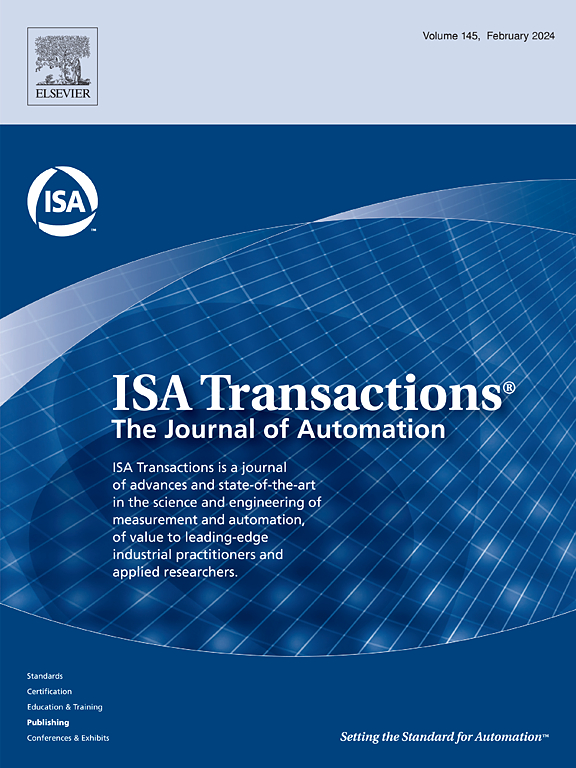Optimal hybrid type-3 fuzzy controller for horizontal axis wind turbines: Comparative study
IF 6.5
2区 计算机科学
Q1 AUTOMATION & CONTROL SYSTEMS
引用次数: 0
Abstract
The blade pitch angle (BPA) controller is key factor to improve the power generation of wind turbine (WT). Due to the aerodynamic structural behavior of the rotor blades, wind turbine system performance is influenced by pitch angle and environmental conditions such as wind speed, which fluctuate throughout the day. Therefore, to overcome the pitch angle control (PAC) problem, high wind speed conditions, and due to type-1 and type-2 fuzzy logic limitations for handling high levels of uncertainty, the newly proposed optimal hybrid type-3 fuzzy logic controller has been applied and compared since type-3 fuzzy controllers utilize three-dimensional membership functions, unlike type-2 and type-1 fuzzy logic controllers. In this paper six different controllers are applied and compared for BPA in WT: type-1 fuzzy logic controller (T1-FLC), interval type-2 fuzzy logic controller (IT2-FLC), interval type-3 fuzzy logic controller (IT3-FLC), optimal hybrid type-1 fuzzy-PID controller (HT1-FPIDC), optimal hybrid type-2 fuzzy-PID controller (HT2-FPIDC), and optimal hybrid type-3 fuzzy-PID controller (HT3-FPIDC). The comparison between Mamdani and Sugeno fuzzy inference systems (FIS) has been applied to find the best inference system. Genetic Algorithm (GA) and Particle swarm optimization (PSO) are used to find the optimal tuning of PID parameters. The results of the 500-kw horizontal axis wind turbine show that Sugeno FIS has higher stability in output power generation than Mamdani FIS. Also, optimal HT3-FPIDC based on Mamdani FIS with PSO provides 19.74 % lower absolute summation error (ASE) than Sugeno FIS in optimal HT2-FLC with PSO and 39.03 % lower ASE than optimal HT1-FLC based on Sugeno FIS with PSO. Finally, the proposed optimal HT3-FPIDC based on PSO and Mamdani FIS provides the optimal results in terms of consistent output power generation at rated value.
水平轴风力发电机最优混合3型模糊控制器的比较研究
叶片俯仰角控制器是提高风力发电效率的关键因素。由于转子叶片的气动结构特性,风力发电机系统的性能受到俯仰角和环境条件(如风速)的影响,这些环境条件全天都在波动。因此,为了克服俯仰角控制(PAC)问题,高风速条件,以及由于1型和2型模糊逻辑对处理高不确定性的限制,新提出的最优混合3型模糊逻辑控制器被应用和比较,因为3型模糊控制器利用三维隶属函数,不像2型和1型模糊逻辑控制器。本文采用了6种不同的控制器,分别是:1型模糊控制器(T1-FLC)、区间2型模糊控制器(IT2-FLC)、区间3型模糊控制器(IT3-FLC)、最优混合型1模糊pid控制器(HT1-FPIDC)、最优混合型2模糊pid控制器(HT2-FPIDC)和最优混合型3模糊pid控制器(HT3-FPIDC)。通过对Mamdani和Sugeno模糊推理系统(FIS)的比较,找到了最佳推理系统。采用遗传算法(GA)和粒子群算法(PSO)对PID参数进行最优整定。对500千瓦水平轴风力机的试验结果表明,Sugeno FIS在输出发电方面比Mamdani FIS具有更高的稳定性。同时,基于Mamdani FIS与PSO的最优HT3-FPIDC的绝对和误差(ASE)比基于Sugeno FIS与PSO的最优HT2-FLC低19.74 %,比基于Sugeno FIS与PSO的最优HT1-FLC低39.03 %。最后,提出的基于粒子群算法和Mamdani FIS的最优HT3-FPIDC在额定值下输出发电量一致的最优结果。
本文章由计算机程序翻译,如有差异,请以英文原文为准。
求助全文
约1分钟内获得全文
求助全文
来源期刊

ISA transactions
工程技术-工程:综合
CiteScore
11.70
自引率
12.30%
发文量
824
审稿时长
4.4 months
期刊介绍:
ISA Transactions serves as a platform for showcasing advancements in measurement and automation, catering to both industrial practitioners and applied researchers. It covers a wide array of topics within measurement, including sensors, signal processing, data analysis, and fault detection, supported by techniques such as artificial intelligence and communication systems. Automation topics encompass control strategies, modelling, system reliability, and maintenance, alongside optimization and human-machine interaction. The journal targets research and development professionals in control systems, process instrumentation, and automation from academia and industry.
 求助内容:
求助内容: 应助结果提醒方式:
应助结果提醒方式:


